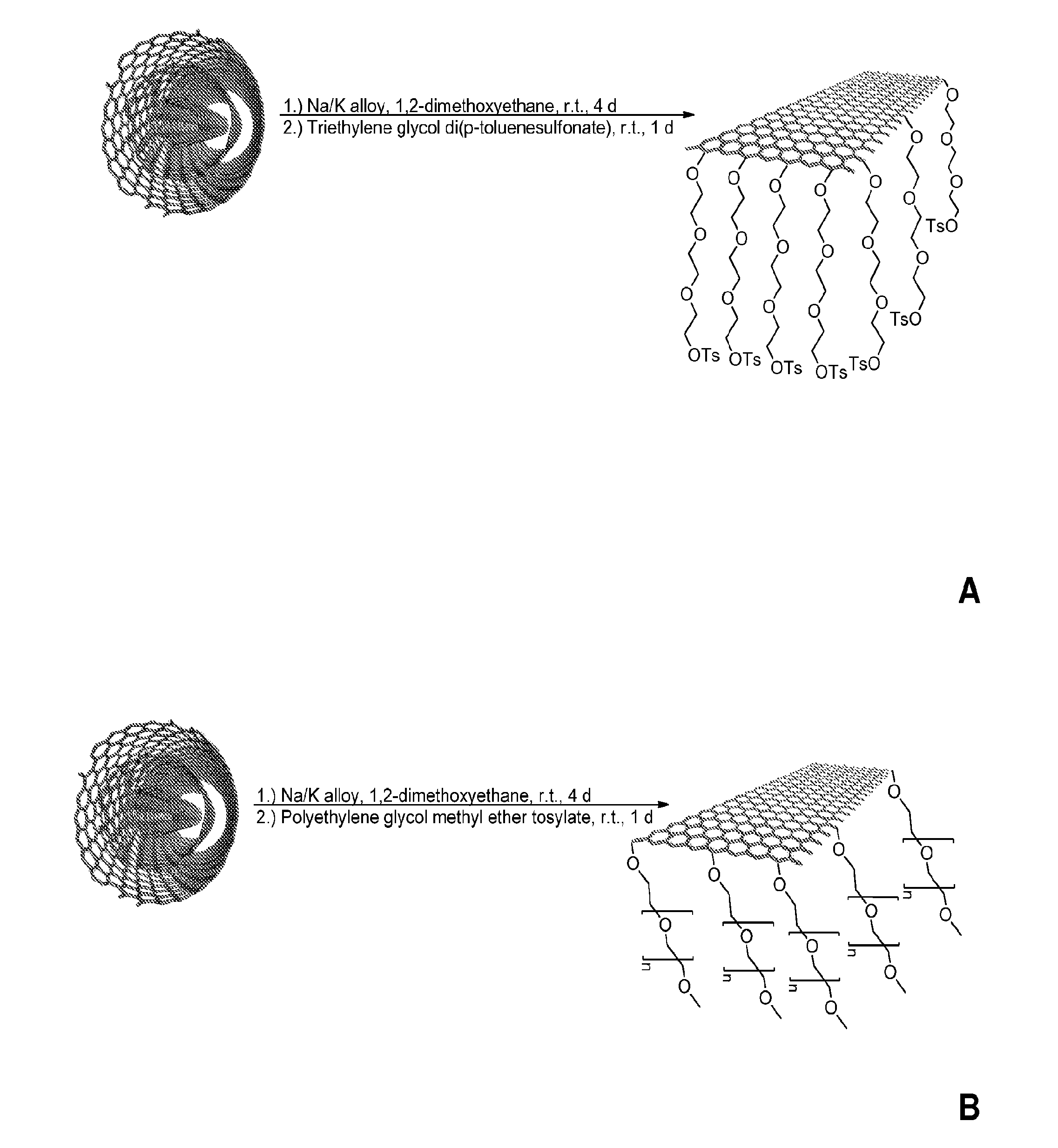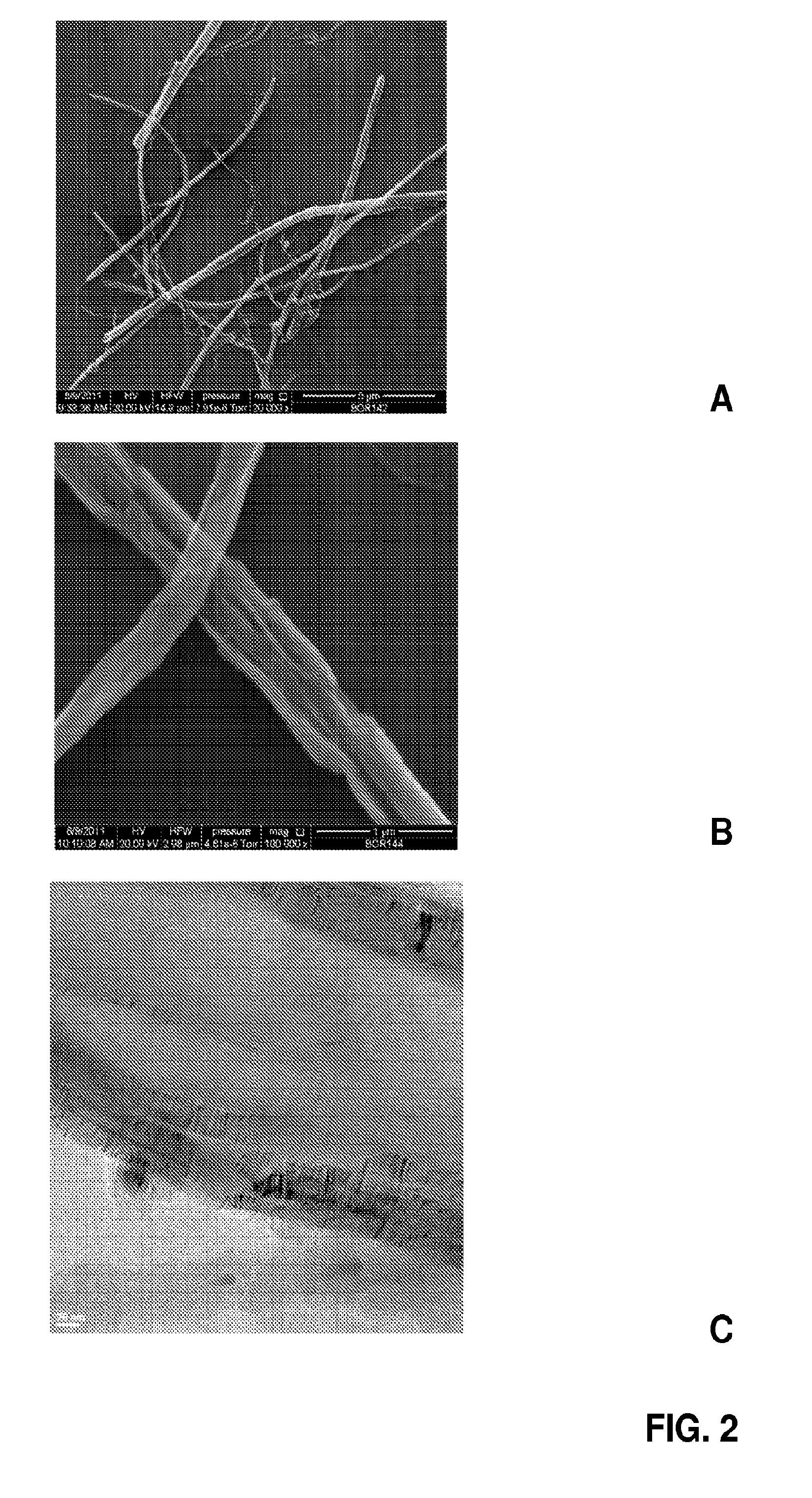Graphene nanoribbon composites and methods of making the same
- Summary
- Abstract
- Description
- Claims
- Application Information
AI Technical Summary
Benefits of technology
Problems solved by technology
Method used
Image
Examples
example 1
Synthesis of Functionalized Graphene Nanoribbons
[0072]The graphene nanoribbons were synthesized by chemical splitting of multi-walled nanotubes with NaK vapor. See, e.g., ACS Nano 5, 968-74 (2011). In a typical synthesis, 0.45 mg of NaK (1:9 by mass) was added into 100 mg multi-walled carbon nanotubes (NTL Composites) with 40 mL 1,2-dimethoxyethane (Sigma Aldrich) added as a solvent. The reaction mixture was stirred on a magnetic stirrer for at least 3 days. In order to functionalize the nanoribbons, a certain amount of electrophilic organic compounds were added and stirred for a day. The reaction mixture was washed with ethanol, H2O, ethanol, THF, and ether in that order.
[0073]The synthetic schemes for the functionalized graphene nanoribbons are shown in FIG. 1. In this Example, two graphene nanoribbons were used. GNR1 (FIG. 1A) was functionalized with triethylene glycol di(p-toluenesulfonate). GNR2 (FIG. 1B) was functionalized with polyethylene glycol methyl ether tosylate.
[0074]I...
example 2
Processing of Nanocomposites
[0077]Nanocomposite samples were made by adding a certain weight percentage of functionalized graphene nanoribbons from Example 1 into an epoxy resin (Aeromarine #300). This was followed by mixing with a rod. The sample was then bath sonicated for 1 hour using a Cole-Parmer Ultrasonic Cleaner. Next, a hardener (Aeromarine #21) was added to the mixture. The mixture was then bath sonicated for 10 minutes. Thereafter, the nanocomposite mixture was cast into a silicone mold and cured for 3 hours at 70° C. on a hot plate. This process worked for any suitable epoxy / hardener combination. Images of the formed composites are shown in FIG. 3.
example 3
DC Conductivity Measurements
[0078]In order to measure conductivity of the formed nanocomposites, 70 nm Pt contacts were sputtered on the top and bottom of the nanocomposite samples in order to reduce contact resistance during measurements. Next, a CEN-TECH Digital Multimeter with a two point probe was used to measure the resistance across the sample.
[0079]Conductivity was determined from two-probe resistance measurements after taking account of the shape and size of the composite. The conductivity of the nanocomposite containing GNR 1 was 0.5 S / m (resistivity, 211.4 Ωcm) at 1.3 wt % loading and 2.4 S / m (resistivity, 41.9 Ωcm) at 3.2 wt % loading. The conductivity of the nanocomposite containing GNR 2 was 3 S / m (resistivity, 29.7 Ωcm) at 3.2 wt % loading. Because the fillers are carbon materials, the conductivity would not be adversely affected over time under room conditions.
[0080]Discussion
[0081]The results achieved herein make it promising to achieve electronic circuit bonding wit...
PUM
| Property | Measurement | Unit |
|---|---|---|
| Temperature | aaaaa | aaaaa |
| Electrical conductivity | aaaaa | aaaaa |
| Electrical conductivity | aaaaa | aaaaa |
Abstract
Description
Claims
Application Information
 Login to View More
Login to View More - R&D
- Intellectual Property
- Life Sciences
- Materials
- Tech Scout
- Unparalleled Data Quality
- Higher Quality Content
- 60% Fewer Hallucinations
Browse by: Latest US Patents, China's latest patents, Technical Efficacy Thesaurus, Application Domain, Technology Topic, Popular Technical Reports.
© 2025 PatSnap. All rights reserved.Legal|Privacy policy|Modern Slavery Act Transparency Statement|Sitemap|About US| Contact US: help@patsnap.com



